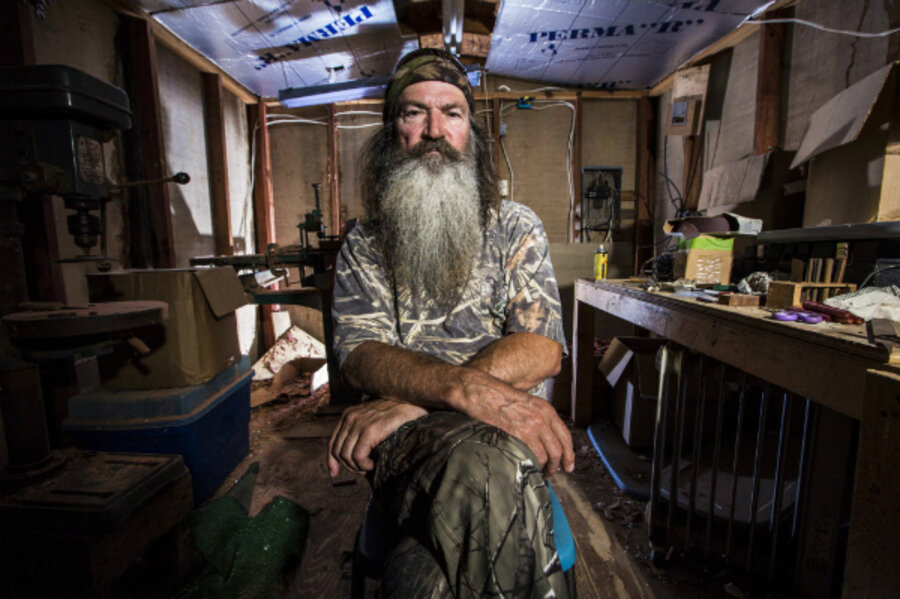Duck Dynasty guns? Yep, but will new product line actually revive hunting?
Loading...
| ATLANTA
Just about everyone in America now knows that Phil Robertson and the “Duck Dynasty” clan are a rare breed, indeed. But even as the bayou-based reality TV family has morphed into a marketing and cultural commodity – note its new line of Mossberg shotguns and rifles – there’s another angle to ponder: Until now, hunters like Phil Robertson had actually been disappearing from America’s duck-dotted wetlands.
"Duck Dynasty" – a show about a band of self-described rednecks and their kin straddling the gulf between rural values and fabulous wealth – built to a TV viewership crescendo this past summer, during its fourth season. It captured even broader attention more recently when Mr. Robertson, the clan patriarch, became embroiled in a corporate spat with A&E executives over his views, expressed to a GQ reporter, that homosexuality is a sin like bestiality, and that homosexuals are akin to drunkards and terrorists.
The Robertsons’ subsequent decision to break away from their TV licensing to sign the Mossberg shotgun deal independently – not to mention the multitude of TV and newspaper stories about the "Dynasty" clan’s red-state attitudes and values – speaks to what some call redneck commoditization. That’s an appeal to primarily white Southern fundamentalist Christians that has translated into financial (some $450 million in merchandise sold in less than two years), as well as cultural and political, payoff.
For "Duck Dynasty" fans, the goal since the A&E flap has been to “bring up the fact that Phil and millions of faith-driven [Americans] have a valid world view, and we’re being excluded from the conversation by those who are intolerant of our view,” says Chris Stone, a Raleigh, N.C., brand marketer and the founder of a nonprofit group called Faith Driven Consumer, which aims to unite Christian shoppers with Christian-friendly businesses.
Now that A&E has lost the standoff and ended Robertson’s suspension, it’s clear that the "Duck Dynasty" legacy may be the extent to which a show about rural Christians who love to “blow a mallard’s head smooth off,” as Phil says in a Mossberg promo, can challenge stereotypes about people in the sticks. More than that, some "Dynasty" champions see the Robertson clan as providing a counterweight to what might be roughly called nonhunting America, a group that’s winning many of today’s big political battles.
Gun culture, the red-blue divide, urban versus rural, Christian versus agnostic, hunters versus nonhunters – the "Duck Dynasty" show has funneled myriad national debates into dollars and influence in a new way.
“Phil Robertson’s comments about gay and black people and social welfare – and the way they pierced public consciousness – explain more about our country’s political culture than almost anything else that happened all year,” Brian Beutler writes on Salon.com.
One way the "Duck Dynasty" brand has made an impact has a lot to do with the kind of guns that Mossberg sells: bird guns. The emergence of "Duck Dynasty" as a cultural phenomenon is happening against a peculiar backdrop along America’s migratory bird flyways from the Missouri River to the Oconee River: While ducks and geese in the US now number nearly 50 million – nearly twice the 1955-2008 yearly average – the numbers of Americans heading out to duck blinds have dwindled over the past few decades. Numbers of hunters usually correlate with numbers of birds, but hunters currently are not keeping up with the duck proliferation.
“Given the recent upward trend for populations of most waterfowl species, we have arguably witnessed the greatest bird abundance and the greatest amount of hunting opportunity during the last 18 years than at any time since the turn of the last century,” a group of state wildlife biologists wrote this summer in Wildlife Society News. “Hunters are living the ‘glory days’ of waterfowl hunting – yet fewer are enjoying the bounty.”
There is, however, one piece of evidence that suggests a shift since the advent of "Duck Dynasty": Sales of US Duck Stamps, needed to hunt migratory fowl but also bought by nonhunters in support of conservation, rose slightly in 2012 from 1.475 million stamps to 1.517 million – the highest number in eight years. "Duck Dynasty" began airing in the spring of 2012, gathering a considerable following by the time the fall duck-hunting season rolled around last year.
The conservation and hunting communities have long worried that “screen time” will replace “outdoor time” for younger generations, and that new hunting traditions are not rising as fast as old ones are crumbling, says Rachel Levin, a spokeswoman for the Duck Stamp Program at the National Wildlife Service.
“Certainly any program or organization that highlights the benefits and joys of duck-hunting, that could certainly spark interest,” Ms. Levin tells the Monitor. “But, again, we don’t have any evidence … that points to a correlation between 'Duck Dynasty' watchers and Duck Stamp sales, or even duck-hunting.”
But the Robertson clan’s own sales numbers could supply proof that a hunting turnaround is under way. The Duck Commander company, begun by Phil Robertson 40 years ago, sold 8,000 duck calls in its first year, 50,000 calls in 2012 after the TV show's debut, and 1 million in 2013 – a testament, yes, to marketing, but also to interest from both hardcore hunters and occasional ones. (How the laid-back crew in the duck call room on the show manages to actually fill those orders is another mystery.)
“While it remains to be seen whether Duck Commander will cement further branding deals [like the one with Mossberg] without A&E’s oversight, what’s clear is that the demand is there,” writes Clare O’Connor in Forbes.








